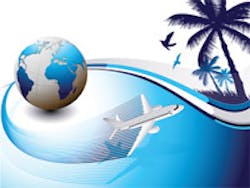Do you catch yourself daydreaming about a tropical vacation, preferably an all-expense-paid one you earn for your work performance? If so, you may not want to pull out that suitcase just yet: According to a recent Incentive Research Foundation (IRF) survey, 62 percent of participating companies said the economy is negatively affecting their incentive planning. While that doesn’t mean organizations can no longer reward employees, they may need to learn how to stretch their incentive dollars.
Melissa Van Dyke, IRF president, acknowledges that current economic conditions are impacting some companies’ reward and recognition programs.
Van Dyke adds, however, that employee recognition is becoming even more important in this new economy, where goals can change dramatically and swiftly. And because compensation structures often can’t flex quickly enough to reflect employee performance as those goals shift, rewards and incentives can help make up the difference.
“Award recognition should stay on the radar as a very important tool in current HR environment,” she stresses.
The Changing Reward Landscape
The IRF survey revealed that economic concerns most affect incentive travel, which traditionally is used as a reward for top performers who have reached a large goal. According to Van Dyke, companies are making the following adjustments in their travel rewards programs:
➤ Sticking closer to home – Organizations are striving to use their travel incentive funds more effectively and make wise destination choices. For example, 83 percent of survey respondents planning incentive travel are targeting U.S. destinations rather than pricier, international options.
➤ Cutting out the extras – Financial concerns have led some companies to consider asking employees to pick up the tab for baggage fees or transportation between airports and hotels.
➤ Offering fewer gifts – Companies concerned about their budgets are eliminating the pricey room gifts that may have previously greeted employees upon checking into their hotels.
➤ Adding a meeting component – Instead of simply offering a free trip to top performers, more organizations are including special business meetings in their travel rewards packages. As long as companies are smart and plan for engaging and interactive activities, employees may appreciate the opportunity for some coveted face time with company leadership and mingle with other top performers.
According to Van Dyke, companies use incentive travel to build loyalty to the organization. “The main goal is creating lasting experiences and memories, and making sure all people feel rewarded and recognized for their efforts,” she says.
Those lasting memories, she adds, could help retain employees – a benefit that will become more important as the economy gains ground.
“There’s somewhat of a retention myth out there right now, that people are just happy to have their jobs. That’s actually not true,” she says. “We’re finding many individuals would leave their job if given the opportunity, and most of them are looking.”
That means that as the economy starts to recover, companies may risk losing their best talent if those employees don’t feel appreciated and rewarded for their efforts. As a result, Van Dyke says, companies must “start looking very strongly at how they reward and recognize those top performers to keep them with the company.”
Of course, travel incentives aren’t the only ways to reward employees – merchandise, cash and gift cards may be less expensive options. IRF found that in these uncertain economic times, many companies are returning to practical rewards, such as apparel or basic electronics. Gift cards, which offer flexibility and allow employees to take advantage of specific sales, also take the pressure off the recognition planner for trying to decide what’s best for their work force.
Communicating Rewards
If budget concerns force an organization to eliminate its incentive programs, Van Dyke reminds company leaders that “communication is absolutely key.”
“If you’re saying, ‘We’re no longer having these trips or these reward and recognition programs,’ you need to have very clear communication for why [that is the case]. Then, let them know what your plan is for getting back to a place where you can provide incentives again,” she explains.
No matter what the financial outlook, all managers should understand the importance of showing their appreciation for an employee’s efforts.
“Simply saying ‘thank you’ and being appreciative of a job doesn’t cost a thing,” Van Dyke points out. “You really need to make sure, at the baseline, that all managers throughout the organization know how to identify when people are going above and beyond and to thank them. Communicate, set a plan and then make sure all your managers are equipped with the tools to engage in individual recognition.”
About the Author

Laura Walter
Laura Walter was formerly senior editor of EHS Today. She is a subject matter expert in EHS compliance and government issues and has covered a variety of topics relating to occupational safety and health. Her writing has earned awards from the American Society of Business Publication Editors (ASBPE), the Trade Association Business Publications International (TABPI) and APEX Awards for Publication Excellence. Her debut novel, Body of Stars (Dutton) was published in 2021.
